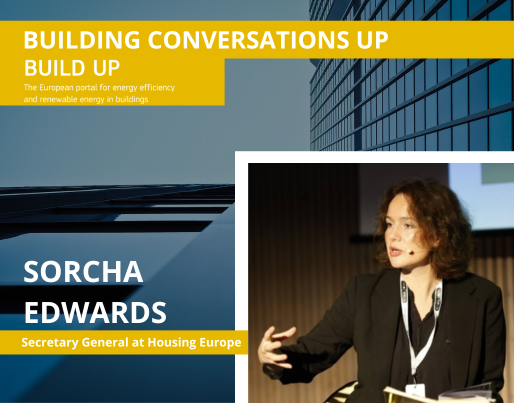Sorcha Edwards: ‘We need a new housing paradigm that can put homes before profit and ensure that everyone can live in a decent home’

Sorcha Edwards: ‘We need a new housing paradigm that can put homes before profit and ensure that everyone can live in a decent home’
Background
Sorcha is General Secretary of Housing Europe, the European Federation of Public, Cooperative and Social Housing since 2014. Housing Europe brings together public, cooperative and social housing providers from across Europe. They share a vision of a Europe which provides access to decent and affordable housing for all, in communities which are socially, economically, and environmentally sustainable and where everyone is enabled to reach their full potential. The sector manages 25 million homes and delivers over 200,000 new homes and renovations annually. Sorcha leads the team and coordinates the network for maximum impact aiming at better regulation, better knowledge, and better finance for housing in EU and International policymaking. Under her leadership, Housing Europe has become a point of reference for sustainable housing systems in Europe and beyond. Sorcha’s academic career, which led her to this position, covered business and languages at Dublin City University, University of Salamanca & University of Ulster, to a Masters in European studies at the University of Leuven, and a post graduate diploma in sustainability in the built environment at the East London University.
BUILD UP (BUP): Can you define housing affordability and how this is linked to energy efficiency?
SORCHA EDWARDS (SE): House prices have risen 50% between 2010 and 2023 while rents rose on average 23%. These averages hide realities where growth has been over 100%, an EU where 46% of people in private accommodation fear losing their homes, and while average mortgage repayments have risen by €3,800 per year, and the cost of new mortgages is 2 percentage points higher due to recent increases. The growing gap between incomes and housing costs and the lack of affordable housing is pushing the right to housing into the realms of theory in many parts of Europe. At EU level, affordability is measured by the overburden rate which indicates whether a household spends more that 40% of their income on housing, however this statistic can miss the point as it does not indicate how much a household has left over to cover, for instance, heating, cooling, and electricity costs after paying their mortgage or rent. The right to housing is intrinsically linked to the right to energy. If carried out in an equitable way by enabling energy efficiency by increasing energy performance of our homes, appliances, and transport, and to access key services and jobs this is at the heart of affordable housing, and therefore the right to adequate housing. However, if the cost of energy efficiency measures falls unfairly on those least able to shoulder those costs, or those without the agency to change consumption patterns (for example through a tax on inefficient homes, heating systems, or cars with poor owners with zero alternative) they can actually be drivers of inequality and a driver of unaffordability.
‘Enabling energy efficiency by increasing energy performance of our homes and appliances and transport to access key services and jobs is at the heart of affordable housing’
This is why a fair energy transition in housing requires a shift in how housing is regulated and financed. Boosting the supply of green social and affordable housing can be key to ensuring that the cost of the energy transition does not fall on the shoulders of those who can least afford it. If social public or non-profit housing is not adequately resourced to raise energy performance, the shedding of stock is a risk as energy efficiency legislation is tightened which will worsen the housing crisis by reducing the supply of affordable housing. On the other hand, if housing is seen as an asset to be exploited increasingly, as has been the case over the last few decades with maximum profit to be extracted, there is no incentive to renovate or invest without a significant return on investment and inevitably higher rents and house prices. It is clear therefore that massive investment with clear social conditionality is required if we are to simultaneously address the energy and housing needs in line with Paris goals without worsening the acute lack of housing.
Housing affordability encompasses more than just the cost we pay to have a roof over our heads. Our housing systems must be resilient, allowing everyone to have a decent life and ensuring that our neighbourhoods are opportunity and productivity hubs for learning, commerce, and culture. This is why one of the biggest challenges for governments today and in the near future would be to factor in climate without pricing out people. This is not an easy task, but everyday Housing Europe hears about real-life examples of how this is already being done in practice.
BUP: Can you mention some examples of good practices of housing providers?
SE: Social, cooperative, and public housing providers have been leading the charge in driving a fair energy transition. As our Housing Europe Observatory report, State of Housing found out, public, cooperative, and social housing stock tends to show better energy performance than privately owned homes. This is thanks to a strong renovation movement within the sector, which in some countries is rather long-standing while in others is more recent. Limited profit housing associations in Austria for instance have already renovated 96% of homes built before 1980.
In Czechia, housing cooperatives have renovated 80% of prefabricated panel blocks. Furthermore, social, and affordable housing providers are involved in exemplary projects and initiatives that are pushing the frontiers with innovative approaches to renovation and decentralised energy production and consumption.
BUP: How can the EPBD impact on housing affordability?
SE: Social and affordable housing providers have been working hard to deliver on their promise from November 2020 to refurbish 400,000 homes a year while also ensuring that the rent for low-income households remains affordable and that enough new homes are made available. A global pandemic, massive increase in material and energy prices have come in the way, delaying expectations and yet, we have seen exemplary social housing projects in different corners of Europe where affordable homes are being revamped at a district level, with new technology, taking the opinion of tenants or residents on board. Once agreed, the EPBD targets will come into the picture of work that had already started.
As recently acknowledged by European housing ministers in the Liége declaration, Europe is facing a housing crisis that is affecting a large section of the population. Facilitating affordable, quality, and sustainable housing will be a core challenge for years to come and the public, cooperative, and social housing sector will have to play a pivotal role in tackling it. The EPBD should therefore not be a catalyst for worsening the housing crisis but instead produce socially inclusive and environmentally sustainable housing systems.
‘Facilitating affordable, quality, and sustainable housing will be a core challenge for years to come and the public, cooperative, and social housing sector will have to play a pivotal role in tackling it’
It is therefore crucial that our sector is provided with sufficient financing to implement the EPBD in a socially just manner. Beyond public and private funding, it will be necessary for the EU to earmark sufficient financing (for instance from the revenues of the Emissions Trading Scheme) to activate inclusive renovations and zero-emission construction. Only by doing so will it be possible for the EPBD to be a driver for environmentally sustainable and affordable housing.
Going beyond best practices, the information we have collected from practitioners on the ground shows reaching the green goals will require a huge effort. E-F-G labels still account for 18% of social housing dwellings that have an energy performance certificate in France, about 15% in Denmark, 11.8% in the Netherlands, 50% in parts of Belgium.
BUP: Have you observed an increasing urgency to make houses more affordable in the EU? Are there relevant differences in each EU countries?
SE: The urgency is growing with recognition of the problem as public housing policy failure threatens political stability and becomes, in some countries, a make-or-break election topic. There are differences between and within countries, however, the problem is facing most governments. The focus on the housing crisis is growing at European level; the European Parliament held a plenary discussion in Strasbourg on the lack of affordable homes and the difficulties people face to find a decent place to live. After a 13-year gap, housing ministers started to meet again to discuss shared challenges and common solutions, and this is now becoming an official part of several EU presidencies conference schedules.
The President of the European Commission, Ursula von der Leyen put forward the New European Bauhaus and European Affordable Housing Initiatives, which both focus on how sustainability, cohesion, and being proud of where we live must and should go hand in hand. These are some of the many available examples, but the reality is that momentum to turn the tides has been growing.
This momentum came mostly from the obvious housing crisis that households have been experiencing in all corners of Europe. The past half-decade has been one of the most disruptive periods for the European continent in recent memory. The COVID-19 pandemic, the invasion of Ukraine by Russia, both of which fuelled an energy and cost-of-living crisis, have put an increased strain on the social fabric of Europe. As expected, these issues have significantly impacted, and will continue to impact, the housing sector too. Multiple issues that existed prior to these events - such as the lack of affordable housing, an increase in the rate of homelessness, higher construction costs, social segregation, and energy poverty have been exacerbated.
BUP: What is the EU strategy and policies to make buildings more affordable and enhance social inclusion? How is the European Affordable Housing Consortium integrated in this context?
SE: The EU has a wide variety of tools through which it can either incentivise socially inclusive and sustainable housing systems or exacerbate the current housing crisis. What we now need is a new housing paradigm that can put homes before profit, and ensure that everyone can live in a decent home. Just as a few examples, we see that EU funding and regulation shape emerging housing systems and reinforce (or potentially undermine) existing ones. The Energy Performance of Buildings Directive (EPBD) shapes neighbourhoods. The Energy Efficiency Directive is a make-or-break tool for residential energy use. State Aid Rules impact housing investments and European Semester country specific recommendations impact national housing policies.
The Affordable Housing Initiative is a tiny drop in the ocean of measures which need to be taken, however, it is putting forward our sector as a model to be followed for a fair energy transition. Two years ago Housing Europe and nine committed partners were tasked by the European Commission with the take-off of the European Affordable Housing Initiative. We accepted the challenge and created a rich and diverse capacity-building programme that provided a set of tools on how to renovate homes for people and have a strong social impact on communities. Our partnership also believed that peers with solid experience must meet and share in detail their renovation path.
Three blueprints with tried and tested approaches are now available to answer housing providers’ questions on how to plan and implement innovative renovations that leave no one behind. They are helping public, cooperative, social housing providers, SMEs, and cities, to answer their questions on the following topics:
Project implementation and financial feasibility
Technology and digital applications
Social inclusiveness and liveability
22 supported districts from different corners of Europe received tailored support for their renovation project. Thirteen mentors helped local actors improve their renovation projects in one-to-one sessions. Four study visits helped about 40 public, cooperative, social housing providers, cities, and SMEs to understand from peers how projects have come to life. A Funding Simulator provides a snapshot of existing public and private finance that can be used for renovation projects at the district level. 450+ engaged housing providers, cities, SMEs through conferences and trainings.
BUP: What innovative solutions or approaches exist to address the housing affordability issue? Can you present some innovative and exemplary projects around Europe?
SE: The Housing2030 report, run by Housing Europe, UNECE and UN-HABITAT, outlined the key buildings blocks that must be in place to sustainably address housing affordability issues. There are no quick fixes as a mix is required of regulation, responsible investment, and institution building. Within those countries we witness innovation to deal with the current lack of housing, such as the transformation of office buildings in Dublin, the use of empty residential buildings for those in need through purchase or sub-letting by the state in Portugal and Hungary, the increase of density by building on top of existing structures in Holland, the roll-out of quality modular and pre-fabricated homes in Norway, Sweden and Germany, rightsizing schemes in Paris.
Additionally, what is old in some countries is innovative in others and we see cost rental housing models common in Austria and Denmark being adopted in Ireland. We see right of use cooperatives common in Switzerland and Germany catching on in Catalonia. We see the Community Land trust model, originally a US model, spreading from Brussels to many cities in France. We see the Danish revolving fund delivering housing for over a century in DK now being applied in Ukraine and Latvia. Measures to reign in out-of-control rents are being taken in Spanish and Irish housing plans with the identification of rent pressure zones. Housing Cooperatives in Norway are running living labs to co-design with residents’ space saving co-housing for ageing well in place. While housing systems vary greatly across Europe, the core elements of the social and affordable housing sector are its community-driven nature and main raison d’être to deliver decent, affordable homes with clear social impact. Our European Responsible Housing Awards that were ranked by tenant unions and city experts have outlined multiple projects that are showing how housing affordability can cater for people in multiple ways.
‘There are no quick fixes as a mix is required of regulation, responsible investment and institution building’
We could take as an example one of the projects that received a New European Bauhaus award. The renovation of Aalborg East is a project derived from a long-term strategy underpinned on resident co-creation to ensure quality of life for the residents. Primarily composed of social housing, this area was built as a satellite city in the 1970s. Construction from this period was characterised by large, uniform, and energy inefficient housing blocks, widespread social unrest, and rental-payment issues. For the past 13 years there was a generalised willingness to overturn the image of Aalborg East. Between 2011 and 2021, the social housing company, Himmerland Boligforening (HB) provided administrative support, led the institutionalisation of cross-sector work (and investment) needed for an integrated solution, and led tenant involvement.
The results were impressive. The transformation improved the attractiveness and reputation of the district bringing 10,000 visitors yearly for training courses at the health centre. It also increased diversity of dwelling types from 3 to 30, and as a result of the improved green spaces there was a rise in the number of active people and the average household income. At the same time, reduction of energy use by 50%, criminality fell by 50% and there was a decline in the share of 20-24-year-olds who only completed primary school by 6.8%.
At a larger scale, we have seen how French social housing providers represented by our member L’Union Sociale pour Logement (USH) signed a long-term alliance agreement with the Banque des Territoires (Caisse des Dépôts group), the European Investment Bank and the Council of Europe Development Bank have established to lay down a foundation for social housing organisations in France to access European funding for long-term investments in affordable homes. This was done back in 2020 and we are now seeing the results of the initiative. The strategic agreement was part of the implementation of the European Union's Recovery Plan from the global pandemic and the EU Renovation Wave, and is now an inspiration for other national governments within the EU.
BUP: What are Housing Europe achievements and goals for the near future concerning housing affordability and social inclusion?
SE: Our key pride is helping to enable our local members to pass on the baton conceived in Amsterdam by museum Het Schip and Pepijn Bakker of the International Social Housing Festival to bring about a revival of the spirit of housing for the common good and bring the social back into social housing. At EU level, together with our members, Housing Europe’s goal is to showcase that support public, cooperative, social, and community-led housing as the backbone of national housing systems and make sure that the EU framework supports that. Through knowledge and exchange, sharing best practices, and providing support to policymakers, we want to help the EU and governments to lead the way out of the housing crisis. This transformation can happen in three steps: by embracing a new housing paradigm, backing a movement for a fair energy transition, and addressing the root causes to end housing exclusion. The more detailed steps are explained in our EU election manifesto.


